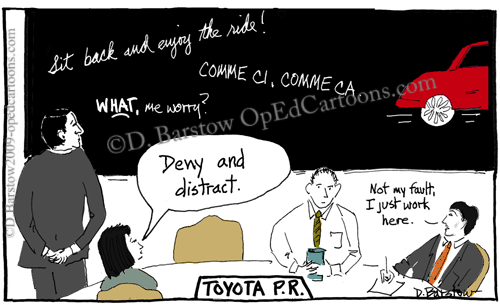Last week, I discussed how Toyota is going to need a miracle in order to regain public trust and save their reputation. Apparently this is more feasible than I previously suspected, according to recent news.
Toyota has high hopes of restoring their reputation as industry leader in quality, environmentally friendly technology and responsiveness to its customers. This past week,
Bulldog Reporter's Daily Dog revealed that Toyota CEO Akio Toyoda and the company's 1,200 U.S. dealers met at the annual dealer meeting in Las Vegas. After recalling more than 9 million vehicles worldwide since its crisis began, Akio Toyoda stated:
"I want Toyota to set a new benchmark in listening to our customers and dealers, sharing critical information and responding better than any car company in history."
However, it’s going to take a lot more than a rally to restore the company’s tarnished imagine. If Toyota is going to talk the talk, they have got to walk the walk, and act on their words.
In April 2010, Toyota launched the SMART evaluation process in response to customer acceleration concerns about Toyota and Lexus vehicles. This SMART evaluation process includes an analysis team made up of more than 200 highly skilled engineers and field technicians, trained to contact customers within 24 hours of a report and, if necessary, arrange for a comprehensive on-site vehicle evaluation. The SMART process has evaluated approximately 4,200 vehicles since the program was launched.
Toyota’s Product Quality and Service Support VP, Bob Waltz, and Kristen Tabar, General Manager of Electronics Systems
Also, last week, Toyota Motor Engineering and Manufacturing North America, Inc. (TEMA) announced that customers' concerns about acceleration problems have dropped by 80 percent since the SMART program began. In addition, Toyota will equip all 2011 vehicles with advanced safety features, including Smart Stop Technology and enhanced event data recorders. Lastly, Toyota is instituting new training protocols in order to strengthen quality, safety and reliability of its vehicles and responsiveness to customer needs (
read more here).
It appears that CEO Akio Toyoda and TEMA are putting in huge efforts to rebuild Toyota's reputation, safety and customer services. Now this is walking the talk.
Until next week :)



 It appears that everyone is jumping on the recall bandwagon. Within the last six months, GM and Nissan have had seven recalls, while BMW, Chrysler and Ford had five each. Overall, the auto industry has had 56 safety recalls for passenger vehicles, according to government data. I began to question the automotive industry as a whole. Are automotive tycoons cutting back on safety procedures and selling cars that are inadequate?
It appears that everyone is jumping on the recall bandwagon. Within the last six months, GM and Nissan have had seven recalls, while BMW, Chrysler and Ford had five each. Overall, the auto industry has had 56 safety recalls for passenger vehicles, according to government data. I began to question the automotive industry as a whole. Are automotive tycoons cutting back on safety procedures and selling cars that are inadequate?






